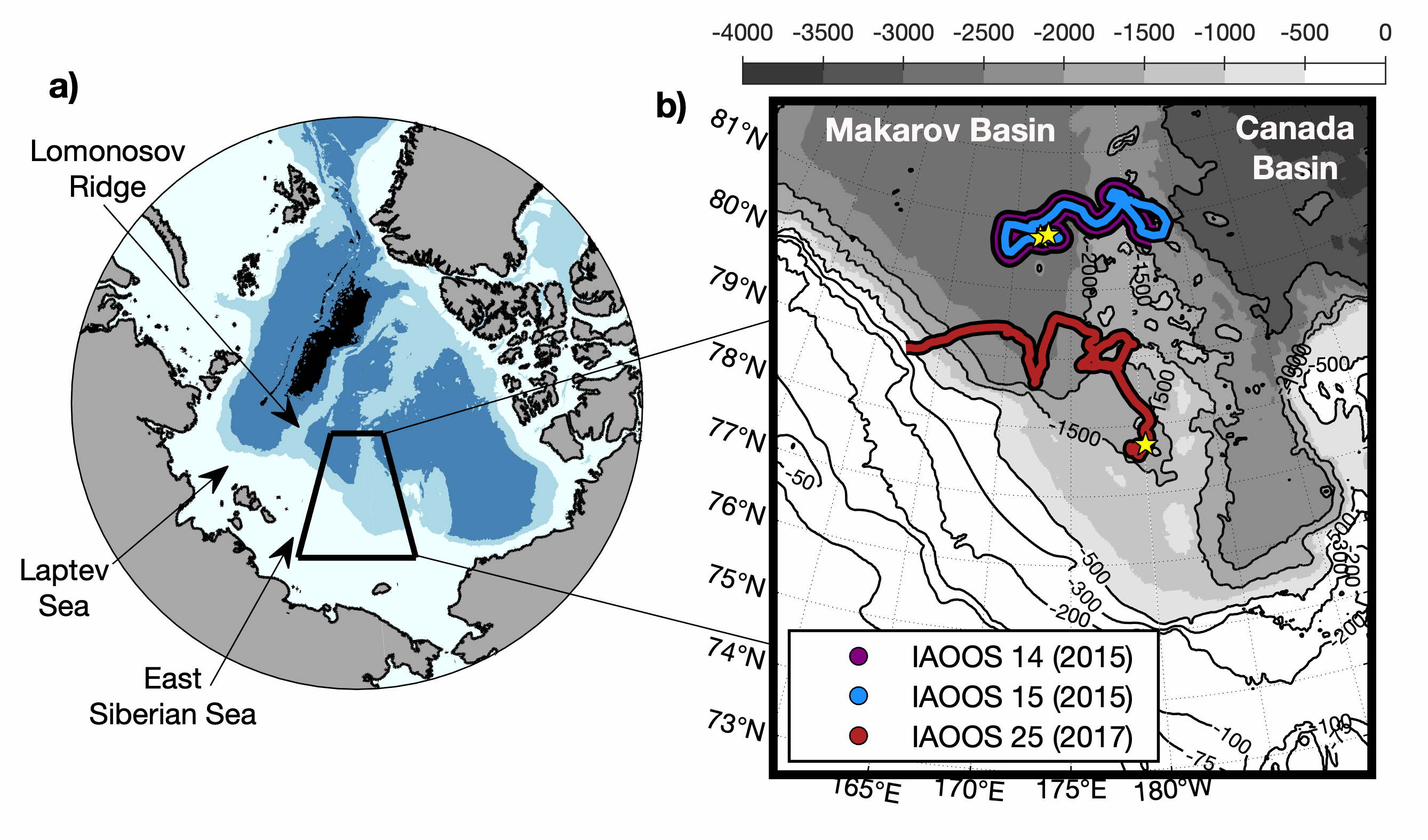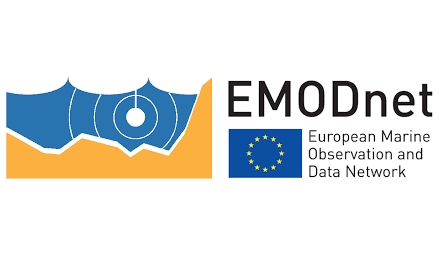Oxygen
Type of resources
Available actions
Topics
INSPIRE themes
Keywords
Contact for the resource
Provided by
Years
Formats
Representation types
Update frequencies
Scale
-

IAOOS14, IAOOS15 and IAOOS25 were deployed from the Korean Icebreaker R/V Araon during cruises in the northern Chukchi Sea. IAOOS14 and IAOOS15 were deployed 300 m apart on the same floe on 12 August 2015 in the Makarov Basin (80.8°N;173°E) and they drifted together remaining always less than 6 km apart. IAOOS25 was deployed on 15 August 2017 south-west Mendeleev Ridge (77.7°N;180°E) and drifted westward to the continental slope of the East Siberian Sea. IAOOS14 and IAOOS25 stopped transmitting on 9 October 2015 and 19 November 2017 respectively, likely due to the loss of their profilers while crossing relatively shallow bathymetry. IAOOS15 dataset ends in 15 October 2015. Ocean profilers were PROVOR SPI (from French manufacturer NKE) equipped with a Seabird SBE41 CTD (Conductivity, Temperature, Depth) and a dissolved oxygen (DO) Aandera 4330 optode. The profilers were set to perform two upward profiles a day from 800 m (IAOOS 14), 300 m (IAOOS 15) and 420 m (IAOOS 25), upward starting at approximately 6 am and 6 pm. The present dataset is composed of CTD-DO data from IAOOS 14 and 15, and CTD data from IAOOS 25 in the Makarov Basin, corrected from salinity errors and interpolated vertically every 0.5 m.
-
Arctic Western Eurasian Basin: IAOOS 23 and IAOOS 24 ocean CTD-DO, CDOM and nitrate profiles in 2017

The two platforms IAOOS 23 and IAOOS 24 were deployed within 600 m from each other at the North Pole from the Russia-operated Barneo ice camp on April 12, 2017. They followed a meandering trajectory, reaching as far as 30°E in the Nansen Basin, before turning back to the western Fram Strait. On both IAOOS 23 and 24, the ocean profiler was a PROVOR SPI (from French manufacturer NKE) equipped with a Seabird SBE41 CTD (Conductivity, Temperature, Depth) and a dissolved oxygen (DO) Aandera 4330 optode. For the first time, the profiler on IAOOS 23 also carried biogeochemical sensors. It featured a bio-optics sensor suite and a submersible ultraviolet nitrate analyzer (SUNA, Satlantic-Seabird Inc.). The bio-optics sensor suite (called Pack Rem A) combines a three-optical-sensor instrument (ECO Triplet, WET Labs Inc.) and a multispectral radiometer (OCR-504, Satlantic Inc.). The present dataset is composed of CTD-DO data from IAOOS 23 and 24, corrected from the thermal lag and the sensor lag, despiked and interpolated vertically every 0.5 m. It also comprises nitrate concentrations from the SUNA and CDOM fluorescence from the WETLabs ECO sensor on IAOOS 23. Other biogeochemical data will be added to this dataset. The profilers were set to perform two upward profiles a day from 250 m (IAOOS 23) and 350 m (IAOOS 24) upward starting at approximately 6 am and 6 pm. They provided a unique 8-month long dataset, gathering a total of 793 profiles of the temperature, salinity and oxygen (upper 350m) and 427 profiles of CDOM and nitrates concentrations (upper 250m).
-

Data obtained from the INRA CARRTEL laboratory in Thonon-les-Bains (SOERE-OLA: Observatory and Experimentation Systems for Environmental Research - LAkes Observatory) in collaboration with CISALB (Inter-Syndical Committee for Sanitation Lake Bourget). These data cover different topics: The variables of the physico-chemistry theme are: nitrogen, calcium, carbon, chlorides, conductivity, magnesium, dissolved oxygen, pH, phosphorus, potassium, reactive silica, sodium, sulphate, temperature, complete alkalimetric titre. Data taken at various depths throughout the lake's water column. The water column is made at the deepest point of the lake (140 m). The samples are taken every 15 days. The period concerns a follow-up from 1999 to the present. The variables of the chlorophyll theme are: chlorophyll a strickland-parsons, chlorophyll c, carotenoids, chlorophyll a scor-unesco, pheopigments. Data taken at various depths throughout the lake's water column. The samples are taken one to three times a month. The period concerns a follow-up from 2006 to the present. The variables of the topic sampling conditions are: air temperature, cloudiness, sunshine, weather, wind direction, wind speed, atmospheric pressure, water aspect, surface condition, transparency, color of water. Studies are carried out approximately once or twice a month. The period concerns a follow-up from 2010 to the present. The variables of the phytoplankton theme are: determiner name, sedimented volume, counting surface, determined taxon, number of counted fields, number of objects counted, number of objects per ml, number of cells per ml, biovolume of species In the sample. Data taken from an integrated depth of 0 to 10m or 0 to 20m depending on the year. Samples are taken once a month. The period concerns a follow-up from 1995 to the present. The variables of the primary production theme are: duration of incubation, primary production by actual incubation duration, primary production per hour, primary production by median third. Data taken at various depths on the lake's water column from 0 to 30m. The samples are taken once or twice a month. The period concerns a follow-up from 2011 to the present. The variables of the probe theme are: depth, temperature, chlorophyll a, pH conductivity, oxygen, oxygen saturation rate, turbidity, transparency, by w, by a, pah, pc. Data obtained at various depths (every 10 cm approximately) over the whole water column of the lake (0 to 140m). Measurements are performed once or twice a month. The period concerns a follow-up from 2003 to the present. The variables of the zooplankton theme are: name of the determiner, sedimented biovolume, name of the taxon determined, stage of development, number of individuals. Data taken from an integrated depth of 0 to 50m. The samples are taken one to three times a month. The period concerns a follow-up from 1996 to the present (absence of data between 1997 and 2003 inclusive).
-

Data from the INRA CARRTEL laboratory in Thonon-les-Bains (SOERE-OLA: Observation and Experimental Systems for Environmental Research - LAkes Observatory) in collaboration with ASTERS (Conservatory of natural areas, preservation of the natural heritage of Haute-Savoie, nature reserves, fauna and flora species). The sentinel lakes are the lakes of: Anterne, Brévent, Bressse inf, Bresse sup, Horn, Cornu, Cos, Jovet, Lauzanier, Malrif, Muzelle, Pave, Pétarel, Pisses, Plan-Vanniey, Porménaz, Rabuons. These data cover different topics: The variables of the physico-chemistry theme are: nitrogen, calcium, carbon, chlorides, conductivity, magnesium, dissolved oxygen, pH, phosphorus, potassium, reactive silica, sodium, sulphate, temperature, complete alkalimetric titre. Data taken at various depths over the whole water column of the lakes concerned (Anterne, Brévent, Cornu, Jovet, Porménaz). The water column is made at the deepest point of each lake. The samples are taken every 15 days. The period concerns a follow-up from 1992 to the present. The variables of the sampling conditions theme (obtained on all the sentinel lakes) are: air temperature, cloudiness, sunshine, weather, wind direction, wind speed, atmospheric pressure, water aspect, Surface, transparency, color of water. Studies are carried out approximately once or twice a month. The period concerns a follow-up since 2013 (or 2014 according to the lakes) until today. The variables of the phytoplankton theme are: determiner name, sedimented volume, counting surface, determined taxon, number of counted fields, number of objects counted, number of objects per ml, number of cells per ml, biovolume of species In the sample. Data taken from an integrated depth of 0 to 5m, 0 to 17m or 0 to 25m depending on the lakes (Anterne, Brévent, Corne, Cornu, Cos, Jovet, Porménaz, Rabuons). Samples are taken once a month. The period concerns a follow-up since 1998 (or 2015 according to the lakes) until today. The variables of the zooplankton theme are: name of the determiner, sedimented biovolume, name of the taxon determined, stage of development, number of individuals. Data taken from an integrated depth of 0 to 24 m for Lake Corne, 0 to 37 m for Cos Lake and 0 to 44 m for Lake Rabuons. The samples are taken one to three times a month. The period concerns a follow-up from 2015 to the present.
-

The MALINA oceanographic campaign was conducted during summer 2009 to investigate the carbon stocks and the processes controlling the carbon fluxes in the Mackenzie River estuary and the Beaufort Sea. During the campaign, an extensive suite of physical, chemical and biological variables was measured across seven shelf–basin transects (south-north) to capture the meridional gradient between the estuary and the open ocean. Key variables such as temperature, absolute salinity, radiance, irradiance, nutrient concentrations, chlorophyll-a concentration, bacteria, phytoplankton and zooplankton abundance and taxonomy, and carbon stocks and fluxes were routinely measured onboard the Canadian research icebreaker CCGS Amundsen and from a barge in shallow coastal areas or for sampling within broken ice fields. This dataset is the results of a joint effort to tidy and standardize the collected data sets that will facilitate their reuse in further studies of the changing Arctic Ocean.
-

EMODnet (European Marine Observation and Data Network) is the long term marine data initiative supported by the European Commission since 2009 to ensure that European marine data will become easily accessible, interoperable, and free on restrictions on use. EMODnet Chemistry provides access to standardized, harmonized and validated chemical data collections for water quality evaluation at a regional scale, as defined by the Marine Strategy Framework Directive (MSFD). The data portal has adopted and adapted SeaDataNet standards and services, establishing interoperability between the data sets from the many different providers (more than 60 in EMODnet Chemistry network). Concentration maps of nutrients, chlorophyll-a and dissolved oxygen are computed on a standard grid, providing information at a regular time interval, per season and over several vertical layers, including the deepest one. Dedicated OGC standard services for browsing, viewing and downloading chemistry observation, data and data products for the European waters have been developed, and are actively maintained and monitored.
-

The PROSOPE (PROductivity of Oceanic PElagic Systems) cruise took place from the 4th of September (Agadir, Morocco) to the 4th of October (Toulon, France) 1999 aboard the RV Thalassa. There were four main scientific objectives: - To carry out classical process studies, typical of JGOFS. - To focus on small scale biogeochemical processes, in particular at a daily scale. - To study the influence of nitrogen, phosphorus and iron on oceanic fertility. - To conduct a calibration/validation operation for the SeaWIFS color sensor.
 Metadata catalogue
Metadata catalogue